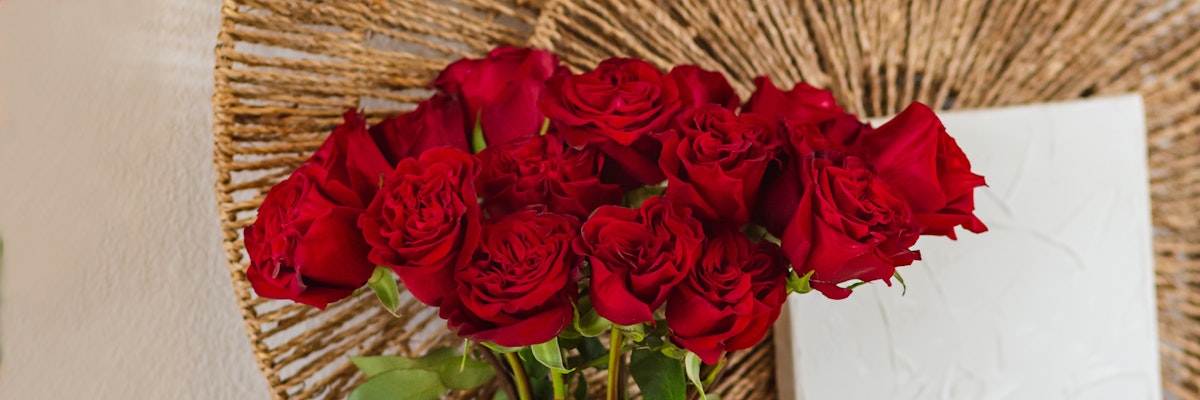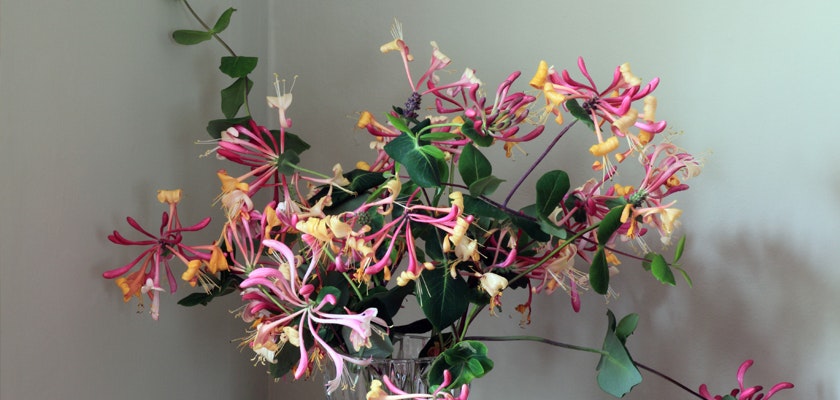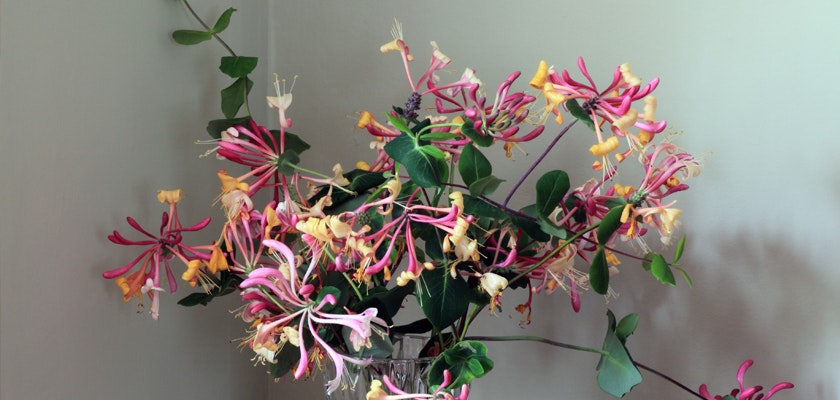Honoring June Birth Flowers: The Timeless Beauty of Roses and Honeysuckle
As June approaches, nature reveals its vibrant colors and fragrances, offering us the delightful embrace of summer.
Discover the beauty and symbolism of June's birth flowers with BloomsyBox
Among the many wonders that June brings, two flowers stand out as symbols of grace, beauty, and affection: the rose and honeysuckle. Whether adorning gardens, bouquets, or cherished moments, these exquisite blooms enrich our lives with their timeless elegance, intoxicating scent, and enduring allure.
Discover the beauty and symbolism of June's birth flowers with BloomsyBox
Among the many wonders that June brings, two flowers stand out as symbols of grace, beauty, and affection: the rose and honeysuckle. Whether adorning gardens, bouquets, or cherished moments, these exquisite blooms enrich our lives with their timeless elegance, intoxicating scent, and enduring allure.
Roses are synonymous with love and beauty, often considered the quintessential flower. Available in a variety of colors, each hue carries its own unique meaning, from the passionate red rose to the gentle pink and the pure white. Roses have been cultivated for thousands of years and hold significant places in history, literature, and art. Their layers of petals and enchanting fragrance have inspired poets, artists, and lovers alike.
Honeysuckle, on the other hand, is known for its sweet nectar and enchanting aroma. These climbing plants add a touch of whimsy to gardens and landscapes, attracting pollinators like bees, butterflies, and hummingbirds. With their tubular flowers and lush green foliage, honeysuckle vines can transform any garden space into a fragrant, vibrant haven. They symbolize the bonds of love, devotion, and the sweet pleasures of life.
Both flowers have rich historical narratives. Roses have connections to ancient civilizations like the Greeks and Romans, who associated them with their deities and used them in celebrations and rituals. Honeysuckle has been admired for its medicinal properties and symbolic meanings in various cultures across the world. These stories add depth to their beauty and make them more than just ornamental plants; they are carriers of cultural heritage and human emotions.
The symbolism of these June birth flowers is deeply rooted in folklore and tradition. Roses have long been symbols of love, passion, and admiration. They are often given as tokens of affection on special occasions like anniversaries, birthdays, and Valentine's Day. Honeysuckle, with its intertwining vines, represents the bonds of love and friendship, making it a popular choice for weddings and romantic settings.
Whether you are celebrating a June birthday, planning a wedding, or simply looking to enhance your garden, the rose and honeysuckle offer timeless elegance and meaning. Their adaptability and resilience make them suitable for various landscaping needs, while their historical and cultural associations add a layer of significance to their presence. Embracing the essence of these June birth flowers can bring a touch of grace and history into your home.
From their care requirements to their fascinating backstories, roses and honeysuckle are more than just flowers—they are symbols of life's enduring cycles and the beauty of renewal. By understanding and appreciating their significance, we can better incorporate these lovely blooms into our lives, whether in our gardens, homes, or special celebrations.
What is the History of Roses?
Roses are believed to have originated in Asia, with evidence of their cultivation dating back at least 5,000 years, particularly in regions of modern-day Iran, China, and Mesopotamia (present-day Iraq). They held symbolic significance in ancient Greek, Roman, Egyptian, and Persian cultures, where they were associated with love, beauty, and ritualistic practices. In classical literature and mythology, roses became emblematic of love and desire, often linked to the goddesses Aphrodite (Greek) and Venus (Roman).
The Romans cultivated roses extensively, using them for ornamental purposes, as well as in festivals, banquets, and religious ceremonies. During Roman feasts, petals of roses would rain down from the ceiling to impress guests. The Renaissance witnessed a resurgence of interest in roses, with botanical gardens, royal courts, and wealthy patrons cultivating rare and exotic varieties. Further, roses prominently appeared in paintings, poetry, and romantic literature of the era.
In medieval Europe, roses became symbols of various noble houses, most famously in the Wars of the Roses between the House of Lancaster (red rose) and the House of York (white rose) in England. This period further cemented the rose's status as a symbol of power and prestige. Additionally, roses played significant roles in religious symbolism, often associated with the Virgin Mary and used in church decorations.
The Victorian era brought about the language of flowers, or floriography, where roses took on additional layers of meaning depending on their color and arrangement. Red roses signified passionate love, while yellow roses represented friendship. This practice allowed people to convey complex emotions and messages through carefully chosen floral arrangements.
Today, roses continue to be one of the most popular flowers worldwide, celebrated for their beauty, fragrance, and versatility. They are cultivated in countless varieties, from hybrid teas to climbers and ground covers, each offering something unique. Roses remain enduring symbols of love, beauty, and romance in contemporary culture, gracing gardens, homes, and special occasions with their timeless charm.
How to Care for Roses
1. Sunlight: Plant roses in a location that receives at least 6 to 8 hours of direct sunlight daily. Adequate sunlight promotes healthy growth and abundant flowering.
2. Soil: Choose well-draining soil rich in organic matter, with a slightly acidic to neutral pH (6.0-7.0). Proper soil conditions support vigorous root development and overall plant health.
3. Watering: Water roses deeply and evenly, keeping the soil consistently moist but not waterlogged. It is best to water in the morning to allow foliage to dry before evening, thus reducing the likelihood of fungal infections.
4. Fertilizing: Apply a balanced fertilizer formulated for roses in early spring as new growth emerges. Repeat applications every 4 to 6 weeks during the growing season (spring through summer) to provide essential nutrients.
5. Pruning: Prune roses in late winter or early spring before new growth begins. Remove dead, damaged, or crossing branches to encourage healthy growth and shape the plant.
6. Mulching: Apply a layer of mulch around the base of the plants to retain moisture, regulate soil temperature, and suppress weeds. Mulching also helps prevent soil erosion and adds organic matter as it decomposes.
7. Pest Control: Monitor roses for common pests such as aphids, spider mites, and Japanese beetles. Use organic pest control methods or insecticidal soap to manage infestations without harming beneficial insects.
8. Disease Management: Ensure good air circulation by spacing plants adequately and avoiding overhead watering. Remove and dispose of any infected leaves promptly to prevent the spread of fungal diseases like black spot and powdery mildew.
9. Winterizing: In colder climates, consider wrapping or mounding soil around the base of rose bushes to protect from frost damage. Use burlap or other protective materials to shield the plants from harsh winter winds.
10. Deadheading: Regularly remove spent blooms to encourage continuous flowering and maintain the plant's appearance. Deadheading redirects the plant's energy toward new growth and flower production.
3 Interesting Facts About Roses
1. Precious Rose Oil: Rose oil is one of the most precious and expensive essential oils in the world. It can take between 4,400 and 8,800 pounds of rose petals to yield just 2.2 pounds of rose oil. This rarity and labor-intensive extraction process make rose oil highly sought after in perfumery and aromatherapy for its luxurious scent and soothing properties. The high concentration of aromatic compounds in rose oil gives it an intense fragrance that is both captivating and therapeutic.
2. Ancient Origins: The oldest fossilized remains of a rose were discovered in Colorado. This fossil, known as "Rosa foetida,” dates back over 35 million years! This remarkable discovery highlights the ancient origins of roses and their long-standing presence in the natural world, captivating humans and wildlife alike. The enduring appeal of roses throughout history underscores their significance in various cultures and civilizations.
3. National Rose Month: June is National Rose Month. It was declared so in 1959 as a way of trying to build support for making the rose the national flower of the United States—a goal that was finally realized in 1986. During this month, celebrations and events honor the beauty and significance of roses, encouraging people to enjoy and appreciate these timeless blooms. National Rose Month provides an opportunity to learn more about the various types of roses, their care, and their cultural importance.
Roses are synonymous with love and beauty, often considered the quintessential flower. Available in a variety of colors, each hue carries its own unique meaning, from the passionate red rose to the gentle pink and the pure white. Roses have been cultivated for thousands of years and hold significant places in history, literature, and art. Their layers of petals and enchanting fragrance have inspired poets, artists, and lovers alike.
Honeysuckle, on the other hand, is known for its sweet nectar and enchanting aroma. These climbing plants add a touch of whimsy to gardens and landscapes, attracting pollinators like bees, butterflies, and hummingbirds. With their tubular flowers and lush green foliage, honeysuckle vines can transform any garden space into a fragrant, vibrant haven. They symbolize the bonds of love, devotion, and the sweet pleasures of life.
Both flowers have rich historical narratives. Roses have connections to ancient civilizations like the Greeks and Romans, who associated them with their deities and used them in celebrations and rituals. Honeysuckle has been admired for its medicinal properties and symbolic meanings in various cultures across the world. These stories add depth to their beauty and make them more than just ornamental plants; they are carriers of cultural heritage and human emotions.
The symbolism of these June birth flowers is deeply rooted in folklore and tradition. Roses have long been symbols of love, passion, and admiration. They are often given as tokens of affection on special occasions like anniversaries, birthdays, and Valentine's Day. Honeysuckle, with its intertwining vines, represents the bonds of love and friendship, making it a popular choice for weddings and romantic settings.
Whether you are celebrating a June birthday, planning a wedding, or simply looking to enhance your garden, the rose and honeysuckle offer timeless elegance and meaning. Their adaptability and resilience make them suitable for various landscaping needs, while their historical and cultural associations add a layer of significance to their presence. Embracing the essence of these June birth flowers can bring a touch of grace and history into your home.
From their care requirements to their fascinating backstories, roses and honeysuckle are more than just flowers—they are symbols of life's enduring cycles and the beauty of renewal. By understanding and appreciating their significance, we can better incorporate these lovely blooms into our lives, whether in our gardens, homes, or special celebrations.
What is the History of Roses?
Roses are believed to have originated in Asia, with evidence of their cultivation dating back at least 5,000 years, particularly in regions of modern-day Iran, China, and Mesopotamia (present-day Iraq). They held symbolic significance in ancient Greek, Roman, Egyptian, and Persian cultures, where they were associated with love, beauty, and ritualistic practices. In classical literature and mythology, roses became emblematic of love and desire, often linked to the goddesses Aphrodite (Greek) and Venus (Roman).
The Romans cultivated roses extensively, using them for ornamental purposes, as well as in festivals, banquets, and religious ceremonies. During Roman feasts, petals of roses would rain down from the ceiling to impress guests. The Renaissance witnessed a resurgence of interest in roses, with botanical gardens, royal courts, and wealthy patrons cultivating rare and exotic varieties. Further, roses prominently appeared in paintings, poetry, and romantic literature of the era.
In medieval Europe, roses became symbols of various noble houses, most famously in the Wars of the Roses between the House of Lancaster (red rose) and the House of York (white rose) in England. This period further cemented the rose's status as a symbol of power and prestige. Additionally, roses played significant roles in religious symbolism, often associated with the Virgin Mary and used in church decorations.
The Victorian era brought about the language of flowers, or floriography, where roses took on additional layers of meaning depending on their color and arrangement. Red roses signified passionate love, while yellow roses represented friendship. This practice allowed people to convey complex emotions and messages through carefully chosen floral arrangements.
Today, roses continue to be one of the most popular flowers worldwide, celebrated for their beauty, fragrance, and versatility. They are cultivated in countless varieties, from hybrid teas to climbers and ground covers, each offering something unique. Roses remain enduring symbols of love, beauty, and romance in contemporary culture, gracing gardens, homes, and special occasions with their timeless charm.
How to Care for Roses
1. Sunlight: Plant roses in a location that receives at least 6 to 8 hours of direct sunlight daily. Adequate sunlight promotes healthy growth and abundant flowering.
2. Soil: Choose well-draining soil rich in organic matter, with a slightly acidic to neutral pH (6.0-7.0). Proper soil conditions support vigorous root development and overall plant health.
3. Watering: Water roses deeply and evenly, keeping the soil consistently moist but not waterlogged. It is best to water in the morning to allow foliage to dry before evening, thus reducing the likelihood of fungal infections.
4. Fertilizing: Apply a balanced fertilizer formulated for roses in early spring as new growth emerges. Repeat applications every 4 to 6 weeks during the growing season (spring through summer) to provide essential nutrients.
5. Pruning: Prune roses in late winter or early spring before new growth begins. Remove dead, damaged, or crossing branches to encourage healthy growth and shape the plant.
6. Mulching: Apply a layer of mulch around the base of the plants to retain moisture, regulate soil temperature, and suppress weeds. Mulching also helps prevent soil erosion and adds organic matter as it decomposes.
7. Pest Control: Monitor roses for common pests such as aphids, spider mites, and Japanese beetles. Use organic pest control methods or insecticidal soap to manage infestations without harming beneficial insects.
8. Disease Management: Ensure good air circulation by spacing plants adequately and avoiding overhead watering. Remove and dispose of any infected leaves promptly to prevent the spread of fungal diseases like black spot and powdery mildew.
9. Winterizing: In colder climates, consider wrapping or mounding soil around the base of rose bushes to protect from frost damage. Use burlap or other protective materials to shield the plants from harsh winter winds.
10. Deadheading: Regularly remove spent blooms to encourage continuous flowering and maintain the plant's appearance. Deadheading redirects the plant's energy toward new growth and flower production.
3 Interesting Facts About Roses
1. Precious Rose Oil: Rose oil is one of the most precious and expensive essential oils in the world. It can take between 4,400 and 8,800 pounds of rose petals to yield just 2.2 pounds of rose oil. This rarity and labor-intensive extraction process make rose oil highly sought after in perfumery and aromatherapy for its luxurious scent and soothing properties. The high concentration of aromatic compounds in rose oil gives it an intense fragrance that is both captivating and therapeutic.
2. Ancient Origins: The oldest fossilized remains of a rose were discovered in Colorado. This fossil, known as "Rosa foetida,” dates back over 35 million years! This remarkable discovery highlights the ancient origins of roses and their long-standing presence in the natural world, captivating humans and wildlife alike. The enduring appeal of roses throughout history underscores their significance in various cultures and civilizations.
3. National Rose Month: June is National Rose Month. It was declared so in 1959 as a way of trying to build support for making the rose the national flower of the United States—a goal that was finally realized in 1986. During this month, celebrations and events honor the beauty and significance of roses, encouraging people to enjoy and appreciate these timeless blooms. National Rose Month provides an opportunity to learn more about the various types of roses, their care, and their cultural importance.
What is the History of Honeysuckle?
The exact origins of honeysuckle are difficult to trace due to its widespread distribution and long history of cultivation. However, historical records suggest that honeysuckle has been appreciated for centuries in various parts of the world. In ancient China, it was used in traditional herbal medicine to treat fevers, inflammation, and respiratory ailments. Its fragrant flowers were also prized for their sweet nectar and beauty.
In European folklore, honeysuckle was believed to bring good fortune to those who planted it near their homes and to offer protection against evil spirits. The plant's ability to thrive and bloom in tough conditions made it a symbol of enduring love and resilience. Honeysuckle was often associated with fidelity and the bonds of love, and it was common to see it used in wedding decorations and bridal bouquets.
During the Victorian era, honeysuckle was often featured in romantic gardens and floral arrangements as a token of affection. The climbing vines and intertwining growth habit of honeysuckle were interpreted as symbols of the unbreakable bonds of love and friendship. Victorians employed the language of flowers (floriography) to express feelings that could not be spoken aloud, and honeysuckle conveyed messages of devoted love and lasting happiness.
In North America, native honeysuckle species were used by Indigenous peoples for various medicinal purposes. The berries, leaves, and flowers were utilized in remedies for sore throats, digestive issues, and skin problems. Honeysuckle's medicinal properties were also recognized by early European settlers, who incorporated the plant into their herbal practices.
Today, honeysuckle vines are popular choices for trellises, fences, and arbors due to their rapid growth and fragrant blooms. However, some non-native species, particularly Japanese honeysuckle (Lonicera japonica), have become invasive in certain regions, outcompeting native vegetation and disrupting ecosystems. Despite these challenges, the beauty and fragrance of honeysuckle continue to make it a beloved addition to gardens and landscapes.
Honeysuckle's cultural significance extends beyond its ornamental and medicinal uses. In literature and poetry, honeysuckle often symbolizes love, devotion, and the sweet pleasures of life. Its ability to attract pollinators such as bees, butterflies, and hummingbirds makes it an essential part of garden ecosystems, contributing to biodiversity and the health of local wildlife populations.
The historical and cultural associations of honeysuckle add depth to its appeal, making it more than just a decorative plant. Its rich history and symbolic meanings remind us of the enduring value of nature's gifts and the connections between plants and human experiences.
How to Care for Honeysuckle
1. Sunlight: Choose a planting location that receives full to partial sunlight. Adequate light encourages healthy growth and abundant flowering.
2. Soil: Plant honeysuckle in well-draining soil that is rich in organic matter. Amending the soil with compost ensures optimal nutrient levels for vigorous growth.
3. Timing: Plant honeysuckle in the spring or fall when temperatures are mild and rainfall is more abundant. This timing allows the plants to establish roots before extreme weather conditions.
4. Watering: Water newly planted honeysuckle regularly to establish roots. Once established, water deeply but infrequently, allowing the soil to dry slightly between waterings. Consistent moisture is essential during dry spells, especially in hot climates.
5. Drought Tolerance: Honeysuckle is somewhat drought tolerant once established, but regular watering during dry periods helps maintain overall health and vigor.
6. Climbing Support: Provide a trellis, arbor, or fence for climbing varieties of honeysuckle to cling to and support their growth. Train vines to climb vertically by gently tying them to the support structure as they grow.
7. Pruning: Prune honeysuckle plants in late winter or early spring to control their size and shape. Remove dead or damaged wood to encourage healthy new growth and improve air circulation.
8. Fertilization: Fertilize honeysuckle in early spring with a balanced, slow-release fertilizer to promote strong growth and abundant flowering throughout the growing season.
9. Mulching: Apply a layer of mulch around the base of the plants to retain moisture, regulate soil temperature, and suppress weeds. Mulching also helps protect the root system from temperature extremes.
10. Pest and Disease Management: Monitor honeysuckle for pests such as aphids, spider mites, and powdery mildew. Use organic pest control methods to manage infestations and ensure good air circulation to prevent fungal diseases.
3 Interesting Facts About Honeysuckle
1. Native vs. Invasive: While many honeysuckle species are native to their respective regions and play crucial roles in their ecosystems, others like Japanese honeysuckle (Lonicera japonica) are considered invasive. Invasive honeysuckles can spread rapidly, outcompeting native plants and disrupting local biodiversity. For gardeners, it's essential to choose non-invasive or native honeysuckle species to support ecological balance and prevent potential environmental harm. Native species offer similar beauty and fragrance without the risk of ecological disruption.
2. Historical Significance: Honeysuckle has been used for centuries in traditional medicine across various cultures. In ancient Chinese medicine, honeysuckle flowers were known for their anti-inflammatory and antiviral properties, used to treat ailments such as colds, fevers, and throat infections. The medicinal use of honeysuckle continues in modern herbal practices, highlighting its enduring significance and therapeutic potential. Herbalists often use honeysuckle extracts and teas to support respiratory health and boost immunity.
What is the History of Honeysuckle?
The exact origins of honeysuckle are difficult to trace due to its widespread distribution and long history of cultivation. However, historical records suggest that honeysuckle has been appreciated for centuries in various parts of the world. In ancient China, it was used in traditional herbal medicine to treat fevers, inflammation, and respiratory ailments. Its fragrant flowers were also prized for their sweet nectar and beauty.
In European folklore, honeysuckle was believed to bring good fortune to those who planted it near their homes and to offer protection against evil spirits. The plant's ability to thrive and bloom in tough conditions made it a symbol of enduring love and resilience. Honeysuckle was often associated with fidelity and the bonds of love, and it was common to see it used in wedding decorations and bridal bouquets.
During the Victorian era, honeysuckle was often featured in romantic gardens and floral arrangements as a token of affection. The climbing vines and intertwining growth habit of honeysuckle were interpreted as symbols of the unbreakable bonds of love and friendship. Victorians employed the language of flowers (floriography) to express feelings that could not be spoken aloud, and honeysuckle conveyed messages of devoted love and lasting happiness.
In North America, native honeysuckle species were used by Indigenous peoples for various medicinal purposes. The berries, leaves, and flowers were utilized in remedies for sore throats, digestive issues, and skin problems. Honeysuckle's medicinal properties were also recognized by early European settlers, who incorporated the plant into their herbal practices.
Today, honeysuckle vines are popular choices for trellises, fences, and arbors due to their rapid growth and fragrant blooms. However, some non-native species, particularly Japanese honeysuckle (Lonicera japonica), have become invasive in certain regions, outcompeting native vegetation and disrupting ecosystems. Despite these challenges, the beauty and fragrance of honeysuckle continue to make it a beloved addition to gardens and landscapes.
Honeysuckle's cultural significance extends beyond its ornamental and medicinal uses. In literature and poetry, honeysuckle often symbolizes love, devotion, and the sweet pleasures of life. Its ability to attract pollinators such as bees, butterflies, and hummingbirds makes it an essential part of garden ecosystems, contributing to biodiversity and the health of local wildlife populations.
The historical and cultural associations of honeysuckle add depth to its appeal, making it more than just a decorative plant. Its rich history and symbolic meanings remind us of the enduring value of nature's gifts and the connections between plants and human experiences.
How to Care for Honeysuckle
1. Sunlight: Choose a planting location that receives full to partial sunlight. Adequate light encourages healthy growth and abundant flowering.
2. Soil: Plant honeysuckle in well-draining soil that is rich in organic matter. Amending the soil with compost ensures optimal nutrient levels for vigorous growth.
3. Timing: Plant honeysuckle in the spring or fall when temperatures are mild and rainfall is more abundant. This timing allows the plants to establish roots before extreme weather conditions.
4. Watering: Water newly planted honeysuckle regularly to establish roots. Once established, water deeply but infrequently, allowing the soil to dry slightly between waterings. Consistent moisture is essential during dry spells, especially in hot climates.
5. Drought Tolerance: Honeysuckle is somewhat drought tolerant once established, but regular watering during dry periods helps maintain overall health and vigor.
6. Climbing Support: Provide a trellis, arbor, or fence for climbing varieties of honeysuckle to cling to and support their growth. Train vines to climb vertically by gently tying them to the support structure as they grow.
7. Pruning: Prune honeysuckle plants in late winter or early spring to control their size and shape. Remove dead or damaged wood to encourage healthy new growth and improve air circulation.
8. Fertilization: Fertilize honeysuckle in early spring with a balanced, slow-release fertilizer to promote strong growth and abundant flowering throughout the growing season.
9. Mulching: Apply a layer of mulch around the base of the plants to retain moisture, regulate soil temperature, and suppress weeds. Mulching also helps protect the root system from temperature extremes.
10. Pest and Disease Management: Monitor honeysuckle for pests such as aphids, spider mites, and powdery mildew. Use organic pest control methods to manage infestations and ensure good air circulation to prevent fungal diseases.
3 Interesting Facts About Honeysuckle
1. Native vs. Invasive: While many honeysuckle species are native to their respective regions and play crucial roles in their ecosystems, others like Japanese honeysuckle (Lonicera japonica) are considered invasive. Invasive honeysuckles can spread rapidly, outcompeting native plants and disrupting local biodiversity. For gardeners, it's essential to choose non-invasive or native honeysuckle species to support ecological balance and prevent potential environmental harm. Native species offer similar beauty and fragrance without the risk of ecological disruption.
2. Historical Significance: Honeysuckle has been used for centuries in traditional medicine across various cultures. In ancient Chinese medicine, honeysuckle flowers were known for their anti-inflammatory and antiviral properties, used to treat ailments such as colds, fevers, and throat infections. The medicinal use of honeysuckle continues in modern herbal practices, highlighting its enduring significance and therapeutic potential. Herbalists often use honeysuckle extracts and teas to support respiratory health and boost immunity.
3. Pollinator Attraction: Honeysuckle flowers are renowned for their ability to attract pollinators, including bees, butterflies, and hummingbirds. The sweet nectar produced by the tubular flowers provides a valuable food source for these creatures, supporting pollination and biodiversity. Planting honeysuckle in gardens can contribute to a healthy ecosystem by attracting and sustaining beneficial pollinators. The presence of honeysuckle can enhance the overall vitality of a garden by promoting natural pollination processes and supporting the lifecycle of various pollinators.
3. Pollinator Attraction: Honeysuckle flowers are renowned for their ability to attract pollinators, including bees, butterflies, and hummingbirds. The sweet nectar produced by the tubular flowers provides a valuable food source for these creatures, supporting pollination and biodiversity. Planting honeysuckle in gardens can contribute to a healthy ecosystem by attracting and sustaining beneficial pollinators. The presence of honeysuckle can enhance the overall vitality of a garden by promoting natural pollination processes and supporting the lifecycle of various pollinators.




